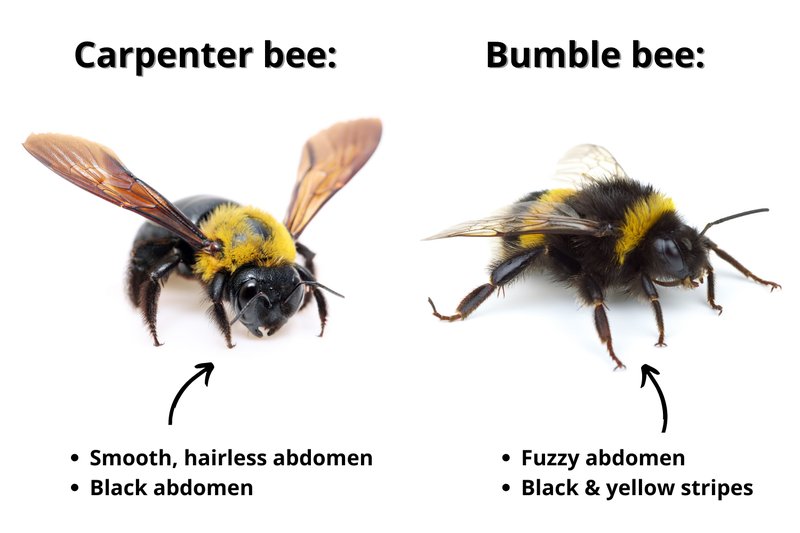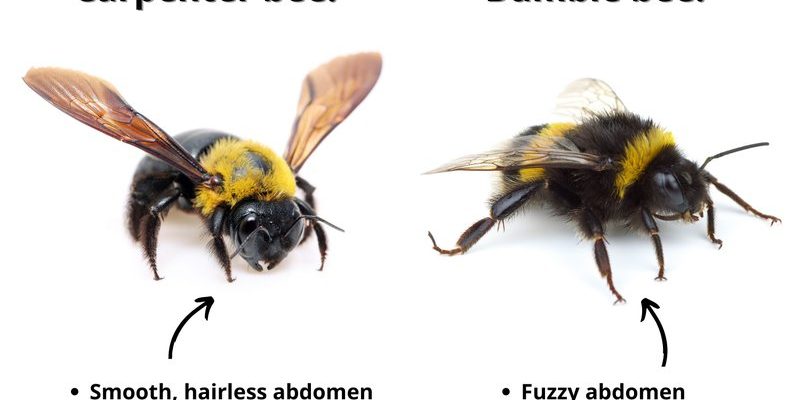
Imagine walking through a sunny garden, surrounded by colorful flowers and a symphony of humming sounds. While many bees work tirelessly to gather nectar, carpenter bees have a bit of a different job description. They’re not just about honey and pollen; they’re also skilled woodworkers! This article will not only spotlight the carpenter bee but also give you a clearer picture of how it stacks up against other bee types. Let’s get started!
What Is a Carpenter Bee?
Carpenter bees are intriguing insects that belong to the genus *Xylocopa*. They’re named for their habit of boring into wood to create nests. While they might look a bit like bumblebees, you can easily spot them due to their shiny, hairless abdomens. They tend to have a more robust build, almost like a tiny linebacker in the bee world!
These bees prefer to nest in soft, untreated woods like cedar or pine, making your garden fence or wooden deck prime real estate. Unlike bumblebees that build their nests underground, carpenter bees excavate tunnels within solid wood. This can cause some damage over time, so it’s crucial to be aware of their presence.
Carpenter bees are also solitary, which means they typically don’t live in colonies like honeybees. Instead, each female bee creates her own nest, laying eggs in the chambers she excavates. Here’s the thing: while they do have a reputation for being a nuisance, they’re also excellent pollinators. So, let’s explore how they compare to other bee types.
How Do Carpenter Bees Compare to Honeybees?
Carpenter bees and honeybees share some similarities, but they each have distinct lifestyles. Honeybees are famous for their social structures. They live in large colonies, work together, and produce honey, which is a staple for humans and other animals alike. In contrast, carpenter bees are solitary creatures that don’t produce honey. They’re more like independent contractors than members of a bustling corporation.
You might notice that honeybees are smaller and have more golden stripes compared to the sleek appearance of the carpenter bee. Additionally, honeybees have a fuzzy body covered with pollen-collecting hairs. Carpenter bees, on the other hand, sport a smooth, shiny abdomen, making them distinguishable at a glance.
In terms of behavior, honeybees are more docile and less likely to sting unless provoked. Carpenter bees can be a bit more assertive, especially when defending their nests. Yet, they’re generally not aggressive unless they feel threatened. If you see one hovering near you, take a moment to appreciate their hard work—they’re just trying to keep their territory safe!
What About Bumblebees?
Bumblebees are another common type of bee that you might confuse with carpenter bees. They’re bigger and fluffier, sporting a rounder body covered in dense hairs. Unlike carpenter bees, bumblebees are social insects that live in colonies. These colonies can host anywhere from a few dozen to a few hundred bumblebees, working together to gather food and raise their young.
A key difference is their nesting habits. While bumblebees often build their homes in abandoned rodent burrows or tussocks of grass, carpenter bees prefer wooden structures. This can lead to some homeowners mistakenly thinking they have a bumblebee problem when it’s actually carpenter bees taking up residence in their deck or siding.
Bumblebees are also more effective at pollinating certain plants because of their unique buzzing technique. They vibrate their bodies while on a flower, releasing pollen that might not be accessible to other types of bees. So, while carpenter bees are great pollinators, bumblebees have a few tricks up their sleeves.
What Makes Mason Bees Different?
Mason bees are another fascinating comparison. Like carpenter bees, mason bees are solitary and known for their wood-boring habits, but they nest in hollow reeds or existing holes rather than creating tunnels in wood. They’re generally smaller and have a more slender body compared to both carpenter and bumblebees.
Mason bees are also notable because they are extremely efficient pollinators, especially for fruit trees. In fact, one mason bee can do the pollinating work of around 100 honeybees! This efficiency makes them a favorite among gardeners who want to enhance their crops.
In terms of behavior, mason bees don’t defend their nests aggressively like carpenter bees do. Instead, they tend to be docile and focus on gathering nectar. If you’re trying to attract beneficial bees to your garden, including mason bees can provide a great balance alongside carpenter bees.
Identifying Carpenter Bees: Signs to Look For
If you suspect carpenter bees are making themselves at home in your yard, there are some tell-tale signs to watch for. One major indicator is the presence of perfectly round holes in wooden structures, usually around half an inch in diameter. These holes can sometimes be accompanied by sawdust that the bees push out while creating their nests.
Keep an eye out for both male and female carpenter bees. Males are more visible and will often hover near their territory. They’re harmless and lack a stinger, but they might buzz around to show off. Females, on the other hand, are busy nesting and are usually found near the entrance to their holes.
Another sign to look for is the sound. If you hear a low buzzing sound and notice large, solitary bees around wooden areas, there’s a good chance you’ve got carpenter bees. Again, while they can cause some damage, remember they are also beneficial pollinators!
Should You Be Worried About Carpenter Bees?
You might be wondering if carpenter bees are more of a problem than a solution. While their nesting habits can cause structural damage to wooden surfaces over time, it’s essential to consider the bigger picture. Carpenter bees are invaluable for pollination, helping to sustain various plants and crops.
If they’re becoming a nuisance, there are several approaches you can take. Preventive measures include painting or treating wood surfaces to deter them from boring holes. If they’ve already settled in, you can use insecticidal dust or even hire a pest control service to help manage the population.
As a last resort, if carpenter bees are damaging a structure, you may need to repair the wood or fill the holes after the bees have vacated. Just make sure to wait until the end of the season, as the bees will need time to complete their life cycle.
Encouraging Beneficial Bees in Your Garden
If you want to attract more bees to your garden—carpenter bees included—there are simple strategies you can implement. Providing a variety of flowering plants can create a welcoming environment for all types of bees. Opt for native plants, as they are perfect for local bee populations!
Additionally, consider leaving some areas of your garden a bit wild. This can provide ideal nesting spots for mason bees and even bumblebees. Leaving bare patches of soil, dead wood, or old logs can give them the perfect place to thrive.
Finally, avoid using pesticides as they can harm beneficial insects. Instead, embrace natural pest control methods and nurture a healthy ecosystem. By fostering diverse habitats, you’ll create an environment where carpenter bees and other pollinators can flourish.
In conclusion, the carpenter bee stands out in the bee world with its unique traits and behaviors. They may sometimes be mistaken for other types of bees, but understanding their differences can help you appreciate their role in our gardens and ecosystems. So, the next time you see one buzzing around your wooden fence, take a moment to recognize the hard work they’re doing. They’re more than just wood-borers—they’re important players in the pollination game!

